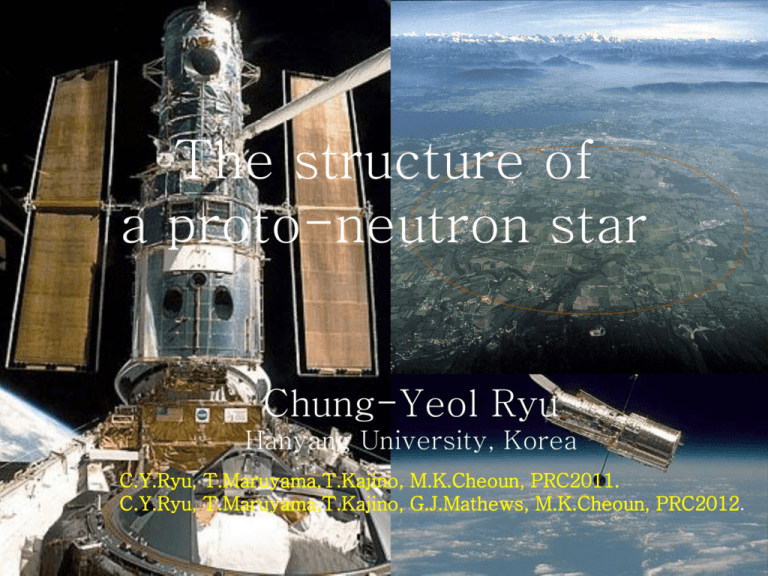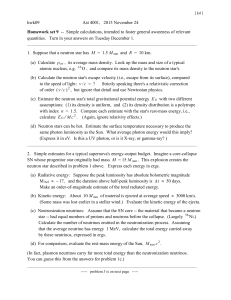ppt
advertisement

The structure of a proto-neutron star Chung-Yeol Ryu Hanyang University, Korea C.Y.Ryu, T.Maruyama,T.Kajino, M.K.Cheoun, PRC2011. C.Y.Ryu, T.Maruyama,T.Kajino, G.J.Mathews, M.K.Cheoun, PRC2012. Outline 1. Introduction 2. Motivations 3. Models and conditions 4. Results 5. Summaries 1. Introduction Vela pulsar The structure of neutron star The depiction of a Shapiro Delay The masses of neutron stars From A. Schwenk 2. Motivations The depiction of a Shapiro Delay Production of a proto-neutron star The structure of supernovae The production of proto-neutron star Supernovae explosion and PNS A. Burrows(1995) Motivation 1 Motivation 2 Isentropic process Burrows&Lattimer APJ (1981), APJ(1987) without convection with convection Motivation 3 S. Reddy et al. PRD(1998) Motivation 4 S. Reddy et al. PRD(1998) A. Burrows’ simulation Idea Beta equilibrium n + νe p + e- : Trapped ratio may depend on densities and temperature. 3. Models and conditions Many body theory in isolated system Microscopic model: Hamiltonian or Lagangian Grand partition function Z Thermodynamic potential Ω - Minimum condition • Chemical potential • Chemical equilibrium for given reaction - Minimum of Gibbs free energy • Equation of state - Energy density, Pressure, Temperature • Observables (mass and radius for neutron star) from EoS Constraints from experiment Neutron star Nuclear matter properties at saturation density Saturation density 0 = 0.15 - 0.17 fm-3 Binding energy B/A =-(ε/ρ – m N )= 16 MeV Effective mass of a nucleon m N*/m N = 0.7 - 0.8 (이론) Compression modulus K-1 = 200 - 300 MeV Symmetry energy asym= 30 - 35 MeV Equation of state from heavy ion collision Symmetry energy from HIC and finite nuclei Symmetry energy Energy per nucleon Energy per nucleon in symmetric matter in asymmetric matter Relativistic mean field model Nucleons (Dirac equation) + meson fields (Klein-Gordon equation) Meson fields mean fields (no transition) Mean fields theory : σ-ω-ρ model Long range attraction (σ meson) + Short range repulsion (ω meson) + Isospin force : ρ meson N N Other mesons are neglected !! pion : (-) parity, other mesons : small effects, simplicity QHD and QMC models Hadronic degrees of freedom : Quantum Hadrodynamics (QHD) σ, ω, ρ Quark degrees of freedom : Quark-meson coupling (QMC) model σ, ω, ρ The Lagrangian of QMC model σ, ω, ρ Eq. of state and entropy Isentropic process : S = 2 (S : entropy per a baryon) The conditions in neutron star 1) Baryon number conservation : 2) Charge neutrality : 3) chemical equilibrium (Λ, Σ, Ξ) - μνe 4) Fixed YL =? or other condition where x is trapped ratio. TOV equation (Mass and radius) • Macroscopic part – General relativity • Einstein field equation : Static and spherical symmetric neutron star (Schwarzschild metric) Static perfect fluid Diag Tμν = (ε, p, p, p) • TOV equation : • Microscopic part – Strong interaction model • equation of state (pressure, energy density) The moment of inertia • Metric tensor • Kepler frequency • The moment of inertia in slow rotating approx. Our picture QHD & QMC models -Eq. of motion • • Baryon number conservation • Charge neutrality • Beta equilibrium with neutrinos Equation of state - Energy density, Pressure, Temperature • Mass, radius and the moment of inertia Trapped ratio depends on densities 4. Results Cold neutron star (QMC) Populations Populations of neutrinos(S=2) Our result A. Burrows’simulation Temperature Equation of state Mass and radius Cold NS(T=0) Proto-NS(S=2) The moment of inertia Summaries 1. Proto-neutron star : After supernovae explosion, the initial state of NS is called PNS. 2. YL = 0.4 condition is not enough to explain trapped neutrino ratio. 3. So, we introduce that the trapped ratio may depend on the baryon densities. - The results agree with simulation. 4. The moment of inertia : PNS CNS - Pulsar rotation may depend on the mass.








